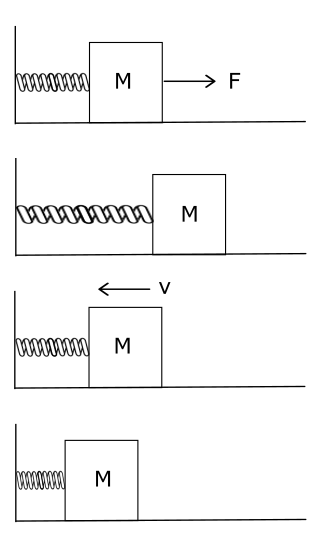LEARNING OBJECTIVE 3.3.A - Describe the potential energy of a system. AP MECHANICS -C LEARNING OBJECTIVE CON 1.B -Explain how the general relationship between potential energy functions and conservative forces is used to determine relationships between the two physical quantities.
In the last section, we introduced the idea of kinetic energy. Kinetic energy stores work by virtue of motion. Let’s now look at other ways of storing work or other forms of energy.
Let us consider two cases in which the performed work is not accompanied by a change in the velocity of the body. First, let’s consider a spring and block system.
A spring is attached to a block of mass M, with the other end fixed to a wall as shown in the figure. If we apply a force F towards the right such that the block starts moving and eventually stops after travelling some distance. Clearly, the force we applied did some work by moving the block, but since the block is finally at rest, there is no gain in the kinetic energy of the block. Then where did the work done by us disappear? The work we did surely didn’t convert into kinetic energy.

To find the answer to this, let’s see what happens when the force F is removed. Once the force F disappears, we will find that the elongated spring pulls the block towards the left and eventually brings the block back to its initial position. This time though the block has acquired a velocity towards the left and hence kinetic energy. This means the work done by us actually got stored in the spring and eventually spring released that energy back by pulling the block back to its original position and also imparting the block the kinetic energy. As the block moves to the left and finally stops all this kinetic energy acquired by the block again gets stored in the spring and finally released back from the spring again elongates.
Let’s consider another case. Suppose we throw a body straight up in the air. Surely we did some work and that work got transformed into the kinetic energy of the body imparting some initial velocity upwards. The body continues to move upward and during this motion, gravity does a negative work by trying to pull it down. Eventually, the body stops after some time and all the kinetic energy we imparted to the body disappears. Where did this kinetic energy go?
We may argue that this kinetic energy disappeared in overcoming the air resistance, and the kinetic energy converted to work. However, the experiments show that even if we throw the ball up in the vacuum the ball stops after some time, and its kinetic energy becomes zero. However, after an object has reached maximum height and its kinetic energy has been reduced to zero, it begins to fall again, still under the acceleration of gravitational force. It falls faster and faster, gaining more and more kinetic energy, and when it hits the ground (neglecting air resistance) it possesses all the kinetic energy with which it started. The kinetic energy re-appears.
It seems reasonable to assume that energy is not truly lost as an object rises upward, but that it is merely stored in some form other than kinetic energy. Work must be done on an object to lift it to a particular height against the pull of gravity, even if once it has reached that height it is not moving. This work must be stored in the form of an energy that it contains by virtue of its position with respect to the gravitational field.
Kinetic energy is thus little by little converted into “energy of position” as the object rises. At maximum height, all the kinetic energy has become energy of position. As the object falls once more, the energy of position is converted back into kinetic energy.Since the energy of position has the potentiality of kinetic energy, the Scottish engineer William J. M. Rankine (1820-1872) suggested, in 1853, that it be termed “Potential energy”
What is potential energy
Coming back to our spring and block system, we find a similar line of argument valid. As the block was pulled by the force the work done by the force was getting stored in the spring due to elongation as a potential energy. When we stopped applying the force this potential energy eventually converted back to kinetic energy moving the block towards the left.
